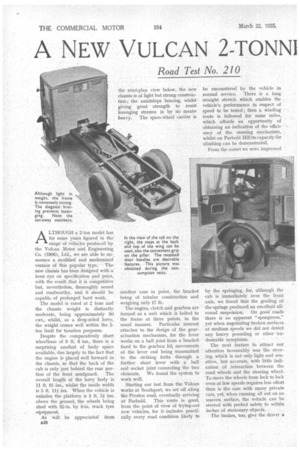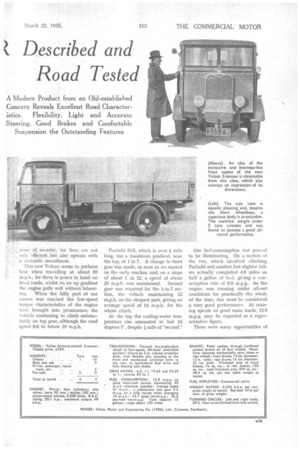EW VULCAN 2-TONNI
Page 52

Page 53

Page 54

If you've noticed an error in this article please click here to report it so we can fix it.
Described and
Road Test No. 210
Road Tested
ALTHOUGH a 2-ton model has for some years figured in the range of vehicles produced by the Vulcan Motor and Engineering Co. (1906), Ltd., we are able to anflounce a modified and modernized version of this popular type.The new chaisis has been designed with a keen eye on specification and price, with the result that it is competitive ' but, nevertheless, thoroughly sound and roadworthy, and it should be capable of prolonged hard work.
The model is rated at 2 tons and the chassis weight is distinctly moderate, being approximately 30 cwt., whilst, as a drop-sided lorry, the weight comes well within the 2ton limit for taxation purposes.
Despite the comparatively short wheelbase of 9 ft. 8 ins., there is a surprising amdunt of body space available, due largely to the fact that the engine is placed well forward in the chassis, so that the back of the cab is only just behind the rear portion of the front mudguard. The overall length of the lorry body is 11 ft. 9/ ins., whilst the inside width is 5 ft. 11+ ins. When the vehicle is unladen the platform is 3 ft. 5i ins. above the ground, the wheels being shod with 32-in. by 6-in, truck tyre equipment As will be appreciated from B38 another case in point, the bracket being of tubular construction and weighing only 17 lb.
The engine, clutch and gearbox are formed as a unit which is bolted to the frame at three points, in the usual manner. Particular interest attaches to the design of the gearactuation mechanism, for the lever works on a ball joint from a bracket fixed to the gearbox lid, movements of the lever end being transmitted to the striking forks through a further short lever with a ball and socket joint connecting the two elements. We found the system to work well.
Starting our test from the Vulcan works at Southport, we set off along the Preston road, eventually arriving at Parbold. This route is good, from the point of view of trying-out new vehicles, for it includes practically every road condition likely to by the springing, for, although the cab is immediately over the front axle, we found that the grading of the springs produced an excellent allround suspension. On good roads there is no apparent "sponginess," yet when negotiating broken surfaces at medium speeds we did not detect any heavy pounding or other 'undesirable symptoms.
The next feature fo attract our attention favourably was the steering, which is not only light and sensitive, but accurate, with little indication of interaction between the road wheels and the steering wheel. To move the wheels from lock to lock even at low speeds requires less effort than is the case with many private cars, yet, when running all out on an uneven surface, the vehicle can be steered with perfect safety to within inches of stationary objects.
The brakes, too; give the driver a StAISC: Of security, for they are not only .e.ilick:nt but also operate with a desirable smoothness.
This new Vulcan seems to perform best when travelling at about 30 m.p.h., for there is power in hand on level roads, whilst on an up gradient the engine pulls well without labouring. When the hilly part of our course was reached the low-speed torque characteristics of the engine were brought into prominence, the vehicle continuing to climb satisfactorily on top gear, although the road speed fell to below 10 m.p.h. Parbold Hill, which is over mile long, has a maximum gradient, near the top, of 1 in 7. A change to third gear was made, so soon as we started on the early reaches, and, on a slope of about 1 in 12, a speed of about 20 m.p.h. was maintained. Second gear was required for the 1-in-7 section, the vehicle maintaining 12 m.p.h. on the steepest part, giving an average speed of 14 m.p.h. for the whole climb.
At the top the cooling-water temperature rise amounted to but 12 degrees F., despite mile of "second."
Our fuel-consumption test proved. to be illuminating. On a section of the run, which ilrrolved climbing Parbold and another hut slighter hill, we actually completed 4.8 miles on half a gallon of fuel, giving a consumption rate of 0.6 m.p.g. As the engine was running under all-out conditions for practically the whole of the time, this must be considered a very good performance. At cruising speeds on good main roads, 12.8 m.p.g. may be regarded as a representative figure.
There were many opportunities of testing brakes in this district. Experimentally, we tried bringing the vehicle to rest, as in an emergency, when negotiating a sharp turn, and, later, when running down a severe incline, but in neither case could we provoke a skid, nor was there the slightest indication Of awkwardness in handling the steering. As our stopping distances (shown on the accompanying braking graph) indicate, efficiencies of a high order were recorded. , The brakes are progressive in action, the retarding force being directly proportional to the driver's efforts. Naturally the effectiveness of the hand brake is inferior, but we found that, on a gradient of 1 in 7, it would hold the' fully laden Vulcan with ease, and would unquestionably be effective on a much steeper slope.
Mention should be inade of the simplicity of the gear change. Although quite strange to the vehicle we were able to make silent changes in both upward and downward directions immediately after taking con trol. In both cases orthodox procedure is adopted, but it is unnecessary, accurately, to gauge the relative speeds of the meshing pinions.
The cab is a practical structure, incorporating many well-thought-out details. For example, there are two mounting plates on each side, in Jinn' with the doors, and a handle grip is mounted on each rearmost side pillar of the cab. Receptacles
are incorporated in each door, and the sliding windows are arranged to give draughtless ventilation. The battery is housed under the seat.
Another point worth recording is that the sides and top of the bonnet come apart readily, it being necessary merely to unfasten four catches to expose the engine. By an arrangement inside the bonnet, heating of the cab is largely avoided. Our only criticism concerns the height of the driver's seat in relation to the top rail of the windscreen. A driver with a long back might find some difficulty in peering beneath the rail.
This new Vulcan is a practical vehicle built to a high-grade specifi cation. It is fast enough for all ordinary purposes, is roadworthy and well.sprung, so that it should fill a useful niche in both the British and overseas markets.




























































































